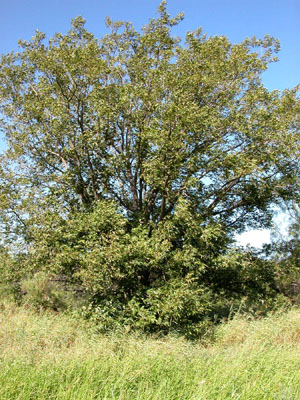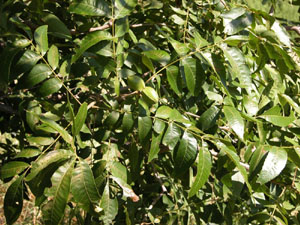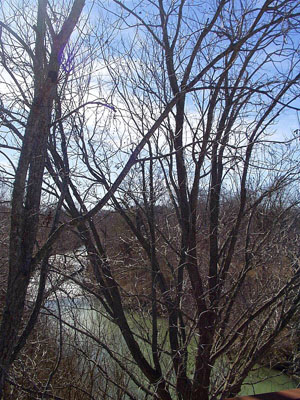Pecan
Carya illinoensis (Wangenheim) K. Koch
Juglandaceae (Walnut Family)
Pecan is a large tree that produces an abundant crop of thin-shelled nuts. Valued for centuries by Native Americans, pecans today comprise one of the most important commercial nut crops in North America. Native pecan grows well in deep soils along streams in east and central Texas, Oklahoma, Louisiana, and Mississippi, and up the Mississippi and Ohio Rivers into Illinois, Kentucky, and southern Indiana. The creek and river terraces of southern Texas house thousands of acres of native pecan trees. The pecan stands of southern Texas were a focal point of Native American subsistence and a regular stop on the seasonal rounds of these hunters and gatherers.
However, there is a catch to relying on pecans as a seasonal or winter food staple. Stands of pecans produce on a biennial cycle, alternating each year between a low-yield harvest and a high-yield harvest. This variation in productivity had an impact on the people who depended on pecans for a source of fat and calories.
Archeological occurrences. Even though the trees are distributed throughout southern and eastern Texas, pecan is seldom recovered from archeological sites on the Edwards Plateau, the South Texas Plains, or the Coastal Plains of Texas. There are three reasons why pecan is not often recovered from archeological sites. First, very few archeological studies have been conducted in areas where pecan stands are the densest, particularly on the lower reaches of the major rivers in Texas. Because it doesn't need to be processed using fire, pecan is probably under-represented in botanical assemblages because it is seldom accidentally charred. Only charred plant remains survive in open archeological sites that are more than a few hundred years old. Finally, pecan may be an uncommon part of the archeological record because pecan shells are thin and relatively delicate.
Despite the fact that pecan is under-represented in the archeological record, it has been reported at a few archeological sites in Texas. Thick layers of pecan were noted in Baker Cave located at the southwestern edge of the Edwards Plateau near Del Rio. The dry deposits of this site provide a perfect environment for the preservation of plant remains, and the earlier layers containing pecan are over 5,000 years old. Interestingly, this discovery may represent an ancient boundary, the western limits of pecan in the region. However, there are some disjunct populations in Mexico and even near Fort Davis that may represent natural occurrences of native pecan.
The Kyle site, located in Hill County, central Texas, contained pecans in 650 year-old archeological deposits. The Varga site, and Indian campsite in Edwards County, contained pecan nut fragments that were about 350 years old. Pecan has also been found at several Caddo Indian sites in eastern Texas, and from a site on the San Gabriel River. As more excavations are conducted in southern Texas, this important food resource is likely to be recovered and identified from many more locations.
Food use. Today pecans are a highly valued food resource, as they have been for thousands of years. The meat of each nut is rich in vegetable oil or fat. Unlike our diet, fat was comparatively scarce in Native American diets. Pecans are a high energy food source, and 100 g of pecan nut meat yields about 690 kcal and that portion contains 72% fat, 9.2% protein, 13% carbohydrates, and only 3.5% water. The nut meat is also packed with 19 vitamins and minerals, including vitamin A, vitamin E, folic acid, calcium, magnesium, phosphorus, potassium, several B vitamins and zinc.
The low water, high energy content of pecans also makes them a compact and readily storable food source. These are qualities that were important to the Native Americans, for they had no pack animals and most other plant food sources required intensive processing before they could be stored. For example, most root foods yield only 40-70 kcal of energy per 100 g, and that portion consists of 80% water, 13% carbohydrates, and less than 0.1% fat. Root foods had to undergo laborious processing to remove the water and concentrate the carbohydrates before they could be stored and eaten.
Pecans are a species of hickory nut, and are closely related to the butternut, mockernut, and black hickory trees. Botanists place all of these trees in the same family as walnuts. The first Old World visitors to see the pecan were not familiar with hickories, for hickories were not native to Europe, but they were very familiar with walnuts. These early explorers called all nuts nueces or nogales, Spanish for walnut and walnut tree, respectively. Interpreting early historic accounts can be difficult because many other species of hickory (Carya), as well as the black walnut (Juglans nigra), grow within the natural range of pecans. However, the pecan is the only tree that produces a thin-shelled, oblong nut. Fortunately many early European travelers provided descriptions or noted locations which likely refer to the distinctive pecan nut.
The first European to observe the use of pecan nuts was Cabeza de Vaca during the early 16th century: "They grind up some little grains with them [the nuts], two months of the year, without eating anything else, and even this they do not have every year, because one year they bear, and the next they do not. They [the nuts] are the size of those of Galicia and the trees are very large and there is a great number of them." (Krieger 2002:189-190). In his account, Cabeza de Vaca uses the Spanish word for walnut (nueces), but the pecan is by far the most abundant nut-bearing tree in the region and the Spanish did not have a word for pecan at that time. He notes that pecan nut production is distinctly biennial, an unusual detail for a traveler to emphasize. The pecan groves encountered by Cabeza de Vaca were probably located on the lower San Antonio and Guadalupe Rivers near Goliad (Krieger 2002:190; 39).
About 150 years later, in February of 1684 members of the Mendoza-Lopez expedition encountered pecans along the Middle Concho River and on the Colorado River just below its confluence with the Concho. The whole party gathered nuts, a welcome change in diet because they had been living on meat alone. Obviously the nuts were left over from the fall crop; many or all were on the ground (Wade 2003:106-113).
While traveling through the area from the Medina to the San Marcos Rivers in 1709, Espinosa wrote: "The nuts are so abundant that throughout the land the natives gather them, using them for food the greater part of the year. For this purpose they make holes in the ground where they bury them in large quantities. Not all the nuts are of the same quality, for there are different sizes and the shells of some are softer than others, but all of them are more tasty and palatable than those of Castile, though they are longer and thinner. The Indians are very skillful in shelling them, taking the kernels out whole. Sometimes they thread them on long strings, but ordinarily they keep a supply in small sacks made of leather for the purpose (Tous 1930:9-11)." The description of the nut as "longer and thinner" is a clear reference to a pecan.
Lacking a word for this tasty nut, Europeans eventually borrowed an Indian word and applied it specifically to the pecan. Use of the word pecan appears in historical records during the early 1700s, when the French along the Mississippi River began using the word paccane or pacanes to refer to the nut-bearing trees growing in the region. This word, a generic term for nuts, is believed to be Algonquian. By the late 18th century, the word pacane was widely used in specific reference to the pecan, and in 1779 Thomas Jefferson received seed stock from New Orleans and planted the pecan at Monticello. New Orleans, the great shipping center for the heart of North America, became known for the distinctive pecan nut, considered by then a great delicacy.
There are not many modern ethnographic records that document pecan as a Native American food source, because most modern ethnographies were conducted in areas outside of the natural range of the pecan. However, the Comanche ate pecans fresh, or stored them without further processing for winter use. Native wild pecan trees are plentiful in the rich valleys of the Comanche country and southward, and the nuts were prized by the Indians.
Medicinal uses. A few medicinal applications have also been noted. The Comanche ground up pecan leaves and applied them to the skin as a poultice for treating ringworm. The Kiowa utilized pecan bark in a decoction that was administered to patients suffering from tuberculosis.
References:
Dering, J. Philip
1977 Baker Cave plant macrofossil report. Unpublished manuscript on file with the Baker Cave Project, Texas Archeological Research Laboratory, University of Texas at Austin
Hall, Grant D.
2000 Pecan Food Potential in Prehistoric North America. Economic Botany 54 (1) pp. 103-112.
Jelks, Edward B.
1962 The Kyle Site: A Stratified Central Texas Aspect Site in Hill County, Texas. Archaeology Series 5. Department of Anthropology, The University of Texas at Austin.
Krieger, Alex
2002 We Came Naked and Barefoot: The Journey of Cabeza de Vaca Across North America. University of Texas Press. Austin.
Quigg, J. Michael, J. D. Owens, G.D. Smith, and M. Cody
2005 The Varga Site: A Multicomponent, Stratified Campsite in the Canyonlands of Edwards County, Texas [Draft]. Technical Report No. 35319. TRC, Inc. Austin, Texas.
Tous, Gabriel
1930 The Espinosa-Olivares-Aguirre Expedition of 1790: Espinosa's Diary. Preliminary Studies of the Texas Catholic Historical Society I(3):1-14.
USDA
2003 USDA National Nutrient Database for Standard Reference.
http://www.nal.usda.gov/fnic/foodcomp/cgi-bin/list_nut_edit.pl
Accessed August 8, 2006.
Vestal, Paul A. and Richard Evans Schultes
1939 The Economic Botany of the Kiowa Indians. Cambridge MA. Botanical Museum of Harvard University.
Wade, Maria
2003 The Native Americans of the Texas Edwards Plateau. University of Texas Press. Austin, Texas.

Pecan tree in early fall loaded with nuts. Stands of pecans produce on a biennial cycle, with productivity varying from high to low from one year to the next. |

Nuts prior to ripening are encased in green hulls. |

A few pecans still hang from these trees along the San Antonio river in this early winter scene. |